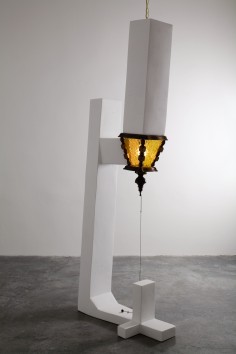BARI ZIPERSTEIN
source: bariziperstein
GROWING BEAMS: sculpture, 2007
Bari Ziperstein’s artistic practice is engaged with the architectural history of Los Angeles and can be read as an investigation of how urban landscapes are defined by consumerism. In 2006, she created a series of intimate collages that deconstruct idealized domestic scenes selected from home décor magazines such as Better Homes & Gardens and Architectural Digest. Within these scenes she transforms posh interiors into quirky environments by adding stark white architectural beams protruding, twisting and bending out of chairs, tables, chandeliers and the like. For her solo debut at Bank in 2007, Ziperstein realized the collages in three-dimensional space within an actual domestic setting: her Los Angeles 1920’s Spanish style apartment. Over fifty site-specific sculptures, made of foam core and plaster, mutate out of decorative and functional objects, rendering an environment that is overgrown, monumental, illusionary and artificial. Ziperstein lived within this environment for three months while completing this ambitious project often having to physically negotiate the space in odd and precarious ways. The photographs illustrate decoration consumed by architectural outgrowths—an interior design gone very much awry.
NEA photography fellow Grant Mudford took the documentation of Ziperstein’s site-specific sculptures. As a regular contributor to Home and Garden, Architectural Digest, and Architectural Record, Mudford applies his commercial and aesthetic sensibility in creating convincing interior photographs of Ziperstein’s sculptural interventions. Furthermore, he is intimately familiar with Southern California architecture, having been commissioned by MOCA LA to extensively photograph Louis I. Kahn and R.M. Schindler architecture, and by the Getty Trust to photograph Frank Gehry’s Walt Disney Concert Hall.
Bari Ziperstein’s work explores America’s perverse love of excess and desire to collect through inventive sculptural tableau. Utilizing a collage aesthetic, her artistic practice draws attention to the way various built environments, ranging from architectural to consumer-oriented constructions, relate to desire and aspiration. Ziperstein creates site-specific sculptures that challenge viewers to discern the familiar from the strange, and to question psychological, economical and emotional attachments that consumers place on spaces and objects.
A selection of recent exhibitions includes Bristol Biennial (2012); Suburban, Chicago (2011); Santa Monica Museum of Art: Wall Works Project (2010); Las Cienegas Projects, Los Angeles (2010); Project Space, Wignall Museum of Contemporary Art at Chaffey College, Rancho Cucamonga (2010); Perk, See Line Gallery, Pacific Design Center, Los Angeles (2009); and (This Isn’t Happening) Popular Hallucinations For Your Home, Bank, Los Angeles (2007). In 2010, Ziperstein’s project ‘1,095: One Year’s Worth of Other People’s Plates’ was featured in Let Them Eat LACMA. Her exhibitions have been reviewed in numerous publications including: The Los Angeles Times, Flash Art, X-TRA, Los Angeles Weekly, Artnet, and Art Papers.
From 2007-2011, she was on the Board of Directors at Side Street Projects and hosted a biweekly podcast series called Shoptalk of frank conversations with contemporary LA artists, sponsored by SSP. She has taught at Cal Arts, CSSSA: California State Summer School for the Arts, University of CA at San Diego and University of CA at Riverside. She is a member of the collaborative team Survey West. Ziperstein holds an MFA from CalArts and double majored at Ohio University to receive a BFA in painting and a Women’s Studies Degree. She lives and works in Los Angeles.
Bari Ziperstein is currently working with “Emma Gray HQ” in Los Angeles.
.
.
.
.
.
.
.
source: inthemake
A lot happens in Bari’s Glasell Park studio. This became clear as soon as we set foot into her space— various objects and materials were scattered about and multiple projects seemed to be underway. Bari has a multifaceted practice that includes ceramic sculptural work, a design line, and various collaborations and she moves between each with a fair amount of ease and focus. I’m always a little surprised when artists manage to do this without becoming discombobulated or overwhelmed; there is always the risk of an effort becoming diluted or disjointed if there are too many influences and ideas on hand.
Yet a good deal of coherence was present in Bari’s work, particularly her series DECORATIVE PROTECTION which she was just finishing up when we visited and is now on exhibit at Emma Gray HQ in Los Angeles. This body of work examines how objects like fences and window bars relate to the female figure, specifically concerning notions of safety and seduction. Inspired by a ‘80s advertisement for wrought iron window bars, Bari draws a parallel between domestic security and womanhood, and explores how in both cases the expectation is that external appearances should be alluring yet simultaneously impenetrable. It’s an unexpected comparison, but by investigating outer displays and protection in the domestic realm Bari considers how female psyche and instincts are formed. Among the sculptural pieces from this series I was particularly drawn to those that took on a human-like size and shape, standing erect and stoic with soft strands of leather falling from their form. Staggering to look at, with a towering, intimidating presence, like fictional she-warriors, these works unapologetically convey both threat and beauty.
As Bari continues to work at many things, I will be curious to see how she balances the different directions that her interests take her. There is a fluidity to her work, she seems to dip in and out of projects seamlessly and is able to grapple with many questions at once… and yet having stood in front of those totemic, almost mythological sculptures I couldn’t help but think that sometimes just one question is enough.


